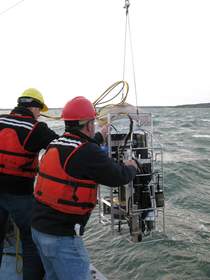COLUMBUS, OH--(Marketwire - February 25, 2010) - Scientists at Battelle and Fluid Imaging Technologies, in Yarmouth, ME, have designed a sensor that can not only better measure changes in the levels of toxic red tide in oceans and algae blooms in the Great Lakes, but also monitor close-to-home problems such as the increase of odor-causing organisms in the public water supply.
Better yet, the results come rapidly -- almost in real time.
The device, called Submersible FlowCAM®, was unveiled this week at the 2010 Ocean Sciences meeting at the Oregon Convention Center in Portland.
Taking up to 22 digital pictures per second, FlowCAM can identify and measure the abundance of many types of microscopic plankton and other water organisms and particles in oceans, lakes, reservoirs and streams and rapidly transmit that data to scientists.
"The upshot is that the Submersible FlowCAM can provide more accurate data faster and more cheaply than taking water samples and carrying them back to a laboratory for analysis," said Carlton Hunt, Research Leader at Battelle's Duxbury, MA, laboratory. "Once you put a boat in the water and you're taking water samples, you have to bring them back and someone has to sit in a lab and look at them."
Battelle scientists teamed with Fluid Imaging Technologies (FIT) to design and build the Submersible FlowCAM. Battelle was responsible for the pressure vessel housing that protects the instrument and the equipment to collect water for analysis. Fluid Imaging Technologies scientists designed the components, which fit inside the pressure vessel, that collect images and analyze the data. The device is based on laboratory and portable monitoring devices FIT has built for environmental monitoring and for quality control in the pharmaceutical, chemical, plastics and other industries.
"We have been aware of the requirement of marine researchers and water quality monitors for an in situ device providing real-time information on microorganisms in water systems ever since we first developed the FlowCAM in 1999," said Harry Nelson, Director of Aquatic Sales for FIT. "Teaming up with the engineering expertise of Battelle, we are very pleased to be able to now offer our imaging technology filling this important need."
The Submersible FlowCAM is 32 inches long, 11.5 inches in diameter, weighs about 115 pounds and is easily transportable. It currently is designed for use at depths up to 656 feet or 200 meters.
The Submersible FlowCAM can be attached to a stationary, underwater mount; attached to moorings; deployed as a profiling instrument with standard water-sampling equipment; carried in the payload bays of underwater robots; or it can be towed. It can be used in salt water as well as fresh water lakes and reservoirs and rivers.
The submersible FlowCAM automatically counts and analyzes algae and other cells and particles continuously in the field or as a bench instrument for more traditional laboratory research and monitoring, providing significantly increased data collection in space and time, said Derek Michelin, a Battelle scientist who worked on the project. The unit captures a digital image of each particle or cell and makes 26 unique measurements, including measuring the fluorescence of the chlorophyll of cells, to help distinguish among different groups of algae. The data is presented in easy-to-read spreadsheets or graphs.
Statistical pattern matching techniques enable automatic classification of taxonomic groups from libraries of known particle images. The result is far faster and more accurate analysis compared with a manually operated microscope, Nelson said.
Data is retrieved directly and immediately through a cable connected to the unit or it can be stored and retrieved later. For remote sensing, the unit could be mounted underwater on a buoy on which is also mounted a transmitter that could be used to retrieve the data.
For climate change research, Hunt said, the Submersible FlowCAM could help scientists construct better climate models by providing more highly resolved plankton data to better understand the global carbon cycle -- which includes the uptake and release of carbon dioxide in oceans. The oceans are a huge carbon sink or buffer, absorbing excess carbon dioxide from the atmosphere. But dissolved carbon dioxide levels in the oceans also depend on the growth, death and decay of ocean plankton, so it is important to accurately track them.
In the Great Lakes, the instrument could help scientists understand the buildup of summertime algae blooms in Lake Erie, particularly the growth of toxic blue-green algae. It also can be used to monitor the organisms in ballast water in foreign freighters entering a port. Contaminated ballast water is a prime source of invasive species.
A unit in a water reservoir could warn of the impending buildup of odor-causing algae before the water makes it to kitchen water taps.
And, because the data is supplied almost immediately, the chance of an unanticipated and undesirable surprise, such as red tide algae on a beach is decreased.
Contact Information:
Media contacts:
Katy Delaney
(614) 424-7208
